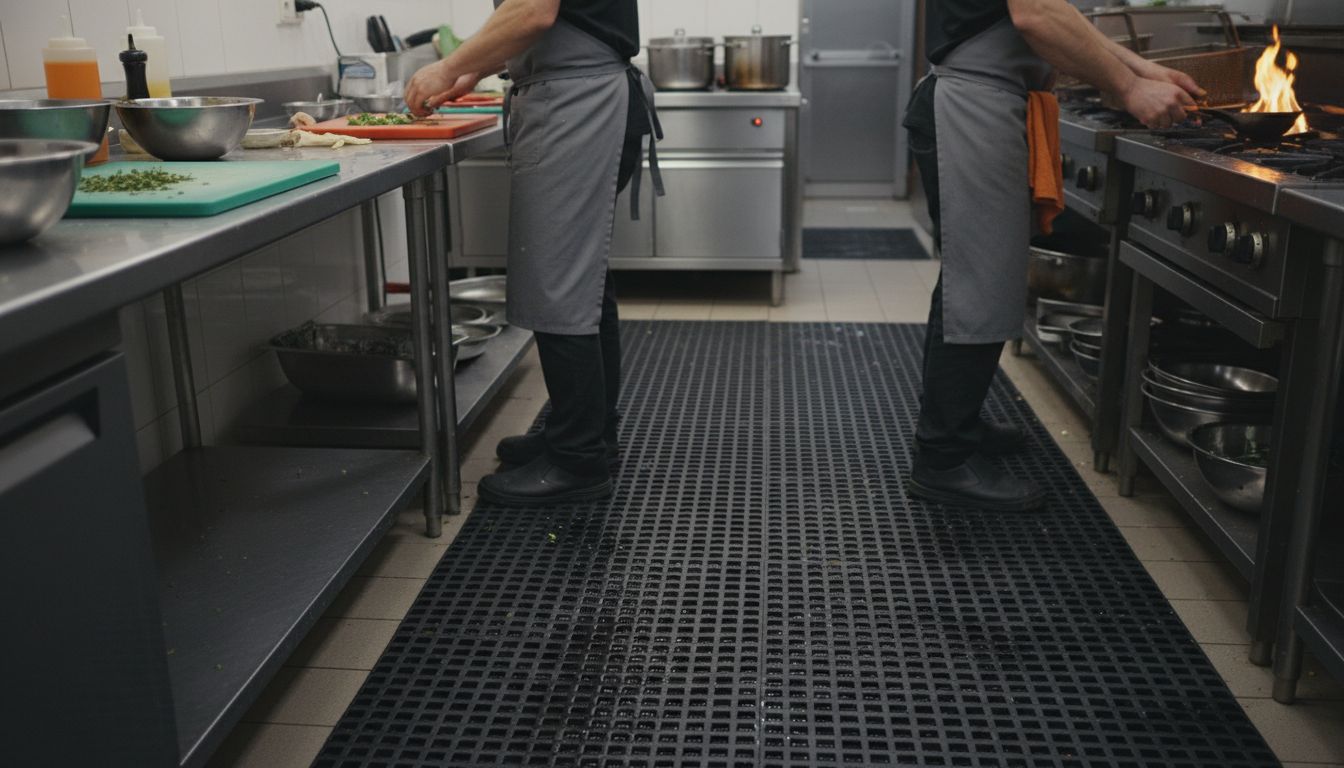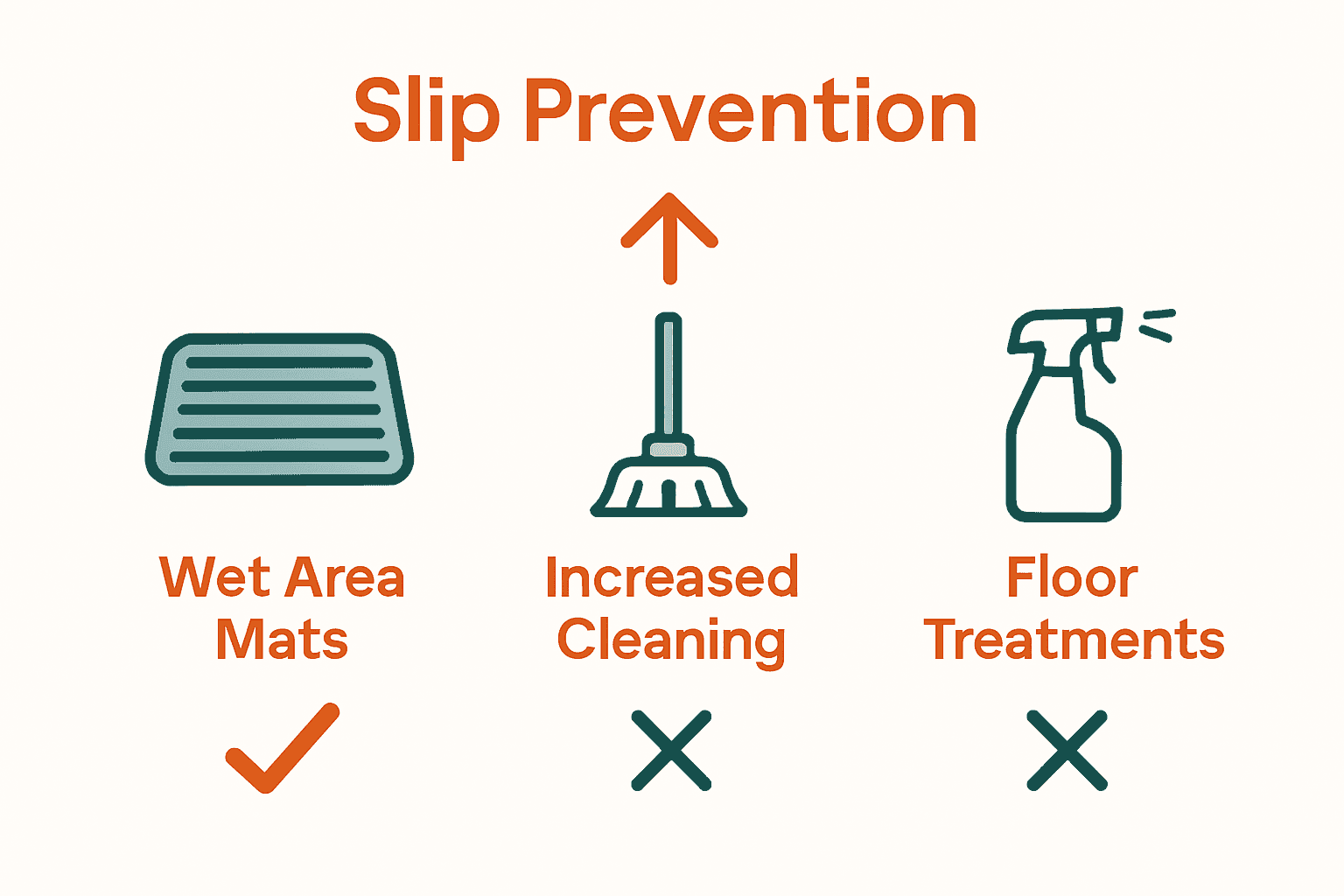Slips and falls remain one of the leading causes of injuries in both workplaces and homes. Research shows that effective entrance matting can reduce slip accidents by up to 90 percent in wet conditions. With water tracked in from rain, spills in kitchens, and moisture in bathrooms, choosing the right door mat goes beyond appearance. This guide breaks down how specialized wet area mats help manage moisture, protect surfaces, and create safer indoor spaces for everyone.
Table of Contents
- What Are Door Mats For Wet Areas?
- Types of Wet Area Door Mats Explained
- Essential Features for Wet Environments
- Common Applications in Commercial Settings
- Maintenance And Durability Considerations
- Comparing Wet Area Mats To Alternative Solutions
Key Takeaways
| Point | Details |
|---|---|
| Importance of Wet Area Mats | Wet area mats are essential for preventing slips and maintaining hygiene in high-moisture environments. They manage water ingress effectively, ensuring safety and protecting flooring. |
| Types and Features | Various mat types, including microfibre and rubber mats, provide specific moisture management capabilities. Key features include high moisture absorption, non-slip surfaces, and quick-drying technologies. |
| Commercial Applications | Wet area mats are vital across commercial settings like retail, healthcare, and hospitality for reducing slip hazards and maintaining cleanliness. They contribute positively to overall safety and professional appeal. |
| Maintenance Needs | Regular cleaning and inspections are crucial for the longevity and performance of wet area mats. Implementing a proactive maintenance strategy ensures ongoing safety and compliance with health standards. |
What Are Door Mats For Wet Areas?
Door mats for wet areas are specialized floor coverings designed to manage moisture, prevent slips, and protect interior spaces from water damage. These critical safety solutions are strategically placed at building entrances, transitions between indoor and outdoor environments, and high-moisture zones like bathrooms and kitchens.
According to Health and Safety Executive, entrance matting systems play a crucial role in preventing slips and falls caused by wet conditions. The primary functions of these mats include:
- Absorbing water and moisture from footwear
- Reducing slip hazards in commercial and residential settings
- Protecting floor surfaces from water damage
- Capturing dirt and debris before it enters interior spaces
Effective wet area door mats are engineered with specialized materials and designs that rapidly capture and contain moisture. Falls Assistant emphasizes that proper mat selection is essential for mitigating potential slip risks, particularly in high-moisture environments like bathrooms and entryways. These mats typically feature advanced water-trapping technologies such as microfibre surfaces, rubber backing, and moisture-wicking fabrics that quickly draw water away from walking surfaces.

For businesses and facilities management, door mats for wet areas represent more than just a functional accessory – they are a critical safety investment. By preventing water ingress and reducing slip hazards, these mats help organisations comply with health and safety regulations while protecting both people and property from potential water-related accidents.
Types of Wet Area Door Mats Explained
Wet area door mats come in a diverse range of materials, designs, and specialized configurations engineered to address specific moisture management challenges in various environments. Health and Safety Executive emphasizes that selecting the right mat type is crucial for effectively preventing slip hazards and managing water ingress.
The primary categories of wet area door mats include:
- Microfibre Mats: Highly absorbent textiles designed to quickly capture and retain moisture
- Rubber Mats: Durable, non-slip surfaces ideal for high-traffic wet areas
- Scraper Mats: Textured surfaces that remove dirt and water from footwear
- Combination Mats: Multi-zone designs with different moisture management sections
Falls Assistant recommends specific mat types based on risk environments. For instance, bathroom mats require high-grip surfaces with exceptional water-wicking capabilities, while commercial entrance mats need robust moisture absorption and durability. Specialized wet area mats often feature advanced technologies like:
- Raised surface patterns for enhanced water drainage
- Anti-microbial treatments to prevent bacterial growth
- Bevelled edges to reduce tripping risks
- Quick-drying materials that minimize water pooling
Understanding the nuanced requirements of different wet areas allows facilities managers to select precisely engineered matting solutions that maximize safety, hygiene, and user comfort.
The right mat isn’t just about aesthetics – it’s a critical infrastructure investment in preventing accidents and maintaining clean, dry environments.
Essential Features for Wet Environments
Selecting the right door mat for wet environments requires careful consideration of multiple critical features that ensure safety, durability, and effective moisture management. Health and Safety Executive emphasizes the importance of comprehensive matting solutions that can handle significant water ingress while maintaining user safety.
Key essential features for wet environment mats include:
- Moisture Absorption Capacity: Ability to quickly capture and retain water
- Non-Slip Surface: Providing reliable traction even when wet
- Robust Material Construction: Resistant to water damage and rapid deterioration
- Quick-Drying Technology: Preventing water accumulation and bacterial growth
Falls Assistant recommends specific design elements that enhance mat performance in wet areas. Critical design considerations include textured surfaces with strategic water channelling, raised edges to prevent water spillage, and materials that maintain structural integrity under continuous moisture exposure.
Advanced wet environment mats now incorporate sophisticated technologies like antimicrobial treatments, ergonomic backing, and specialized fabric weaves that dramatically improve moisture management. Complete Guide to Rubber Floor Mats for Wet Areas highlights how innovative materials can transform safety protocols in high-risk environments, turning what was once a potential hazard into a proactive safety solution. For facilities managers and safety professionals, investing in high-performance wet area mats is not just about aesthetics – it’s a critical strategy for preventing accidents, maintaining hygiene, and protecting both people and infrastructure.
Common Applications in Commercial Settings
Wet area door mats play a crucial role in maintaining safety and hygiene across numerous commercial environments. Health and Safety Executive emphasizes the critical importance of entrance matting systems in managing water ingress and preventing slip hazards, particularly in high-traffic commercial spaces.
Key commercial settings that benefit from specialized wet area mats include:
- Retail Environments: Supermarkets, shopping centres, and retail stores
- Hospitality Sectors: Restaurants, hotels, and reception areas
- Healthcare Facilities: Hospitals, clinics, and medical reception zones
- Industrial Workspaces: Manufacturing floors, warehouses, and processing areas
- Educational Institutions: School entrances, laboratories, and cafeteria zones
The HSE highlights specific examples of how strategic mat placement can dramatically reduce workplace accidents. Commercial matting solutions are not just about preventing slips – they serve multiple critical functions such as:
- Capturing dirt and moisture before it enters interior spaces
- Reducing cleaning and maintenance costs
- Protecting expensive flooring from water damage
- Creating a professional first impression for visitors
For businesses across the UK, investing in high-quality wet area door mats represents a proactive approach to workplace safety. These mats transform potential hazard zones into secure, hygienic environments, demonstrating a commitment to both employee and customer well-being. Beyond safety, they contribute to a more professional, clean, and efficiently managed commercial space.
Maintenance And Durability Considerations
Health and Safety Executive underscores that proper maintenance is fundamental to ensuring the long-term effectiveness and safety of wet area door mats. Regular care directly impacts a mat’s performance, durability, and ability to prevent slip-related accidents in commercial and institutional environments.
Key maintenance protocols for wet area mats include:
- Daily Surface Cleaning: Removing debris and preventing dirt accumulation
- Weekly Deep Cleaning: Thorough washing to maintain moisture absorption
- Monthly Comprehensive Inspection: Checking for wear, damage, or reduced traction
- Seasonal Replacement: Implementing rotation and replacement strategies
Falls Assistant recommends specific durability considerations that extend mat lifecycle and maintain safety standards. Critical maintenance factors involve understanding material degradation, recognizing early signs of wear, and implementing proactive replacement strategies before performance significantly declines.
Durability in wet area mats is determined by multiple interconnected factors such as material quality, frequency of use, cleaning protocols, and environmental conditions. Professional facilities managers should develop comprehensive mat maintenance programmes that include regular cleaning, prompt repairs, and strategic replacement. This approach not only ensures ongoing safety but also represents a cost-effective strategy for long-term risk management in wet and high-traffic environments.
Comparing Wet Area Mats To Alternative Solutions
Health and Safety Executive provides a comprehensive analysis of alternative solutions for managing wet environments, highlighting that wet area mats offer unique advantages over other slip prevention strategies. While multiple approaches exist, specialized matting remains the most cost-effective and immediately implementable safety solution.
Comparative safety solutions include:
- Increased Cleaning Protocols: Labour-intensive and less consistent
- Floor Treatments: Expensive and requiring professional application
- Warning Signage: Passive and reactive rather than preventative
- Handrail Installation: Structural modification with limited effectiveness
- Wet Area Mats: Direct, adaptable, and immediately impactful
Falls Assistant emphasizes that non-slip mats provide a superior alternative by offering multiple simultaneous benefits. Unlike structural modifications or signage, wet area mats actively manage moisture, provide immediate traction, and can be quickly replaced or updated without significant investment.

The comparative analysis reveals that wet area mats represent a holistic solution, addressing safety concerns through design innovation. Professional facilities managers recognize that these mats are not just an accessory but a strategic risk management tool that combines prevention, hygiene, and cost-effectiveness in a single, adaptable product. Best Mats for Wet Areas – Expert Comparison 2025 further validates the comprehensive advantages of specialized matting solutions across diverse commercial environments.
Ensure Safety and Cleanliness with Expert Wet Area Mats
Managing moisture and slip risks in wet areas is a challenge that every home and business faces. The article highlights the importance of mats engineered for absorption, durability, and non-slip properties to protect your floors and keep users safe. If moisture and slips are concerns in your entrances, kitchens, or other wet zone environments, the right door mat can make a crucial difference.
Explore our extensive range of Indoor Entrance Mats designed specifically to capture water and dirt effectively, reducing slip hazards. For specialised commercial spaces like kitchens and hospitality areas, our Mats for Restaurants and Kitchens collection offers durable and easy-to-maintain solutions that meet hygiene and safety standards.

Don’t wait until moisture causes damage or accidents become a real threat. Visit Mats4U now to find customisable, high-performance mats tailored to your wet area needs. Protect your premises and everyone who steps inside with mats that combine safety, durability, and style in one smart solution.
Frequently Asked Questions
What are door mats for wet areas?
Door mats for wet areas are specialized mats designed to absorb moisture, prevent slips, and protect interior spaces from water damage. They are crucial for safety, especially in high-moisture zones like bathrooms and kitchens.
What materials are commonly used in wet area door mats?
Wet area door mats are typically made from materials such as microfibre for absorption, rubber for durability, textured surfaces for scraping dirt, and combinations of these for optimized moisture management.
How do I maintain wet area door mats?
Proper maintenance includes daily surface cleaning to remove debris, weekly deep cleaning to maintain moisture absorption, monthly inspections for wear and damage, and seasonal replacements as needed to ensure ongoing safety and effectiveness.
What features should I look for in a wet area door mat?
Key features to consider include moisture absorption capacity, non-slip surfaces for traction, robust material construction to resist water damage, and quick-drying technology to prevent bacterial growth and water pooling.









